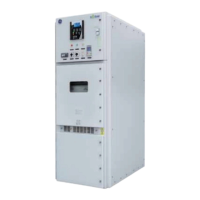DET-882 SecoGear Medium-voltage Switchgear Application and Technical Guide
System and Equipment Protection
©2017 General Electric All Rights Reserved 31
Bus Protection
Bus-differential relays should be applied to generator
buses, buses with high available short-circuit current, and
buses that, if faulted, create system disturbances that
could lead to system instability in other portions of the
system if the fault is not rapidly isolated. High-speed bus
differential can also reduce the level of incident energy
released during an internal arcing fault, increasing
operator safety and reducing equipment damage.
This type of relaying uses equally rated phase-current
transformers of like characteristics in each circuit
connected to or from the bus to be protected. GE Multilin
offers three-phase bus-differential relays (87B) with the
B30 and B90 relays. B30 can be used on a high-impedance
bus differential with the addition of the Multilin HID module.
B90 is for low-impedance applications.
Transformer Protection
Transformer-differential relays (87T) are high-speed relays
with harmonic restraint. These relays use current
transformers of different ratios and connections and
compensating relay taps. Liquid-filled transformers, larger
than approximately 5000 kVA, are protected usually with
both differential and fault-pressure relays (63FP) and
occasionally with gas-detector relays.
Differential relays protect the internal transformer circuit,
including conductors, bushings and windings. Fault-
pressure relays provide excellent internal tank-fault
protection for liquid-filled transformers, but do not include
the entire circuit in the protected zone.
Transformers connected delta-wye, with the secondary
neutral grounded through resistance, frequently require
ground-fault as well as phase-fault differential protection
because the pickup of phase-differential relays may not be
low enough to detect secondary ground faults. This results
from the large CTs necessary to carry transformer load
currents at forced air ratings. For such systems, the GE
Multilin SR845 Transformer Protection relay can be used
for complete protection.
Motors
Motor differential relays are usually applied to motors
1500 HP and larger. Three-phase motor-differential relays
(87M) used for this application employ the balanced-
current principle. This type of protection provides for
detecting motor-fault currents as small as 15 A. In some
applications, differential relay schemes are used to protect
both the motor and its feeder cable. These schemes use
three CTs on each side of the motor.
Transmission Line
Line-differential protection (87L) for short lines and
important tie lines between medium-voltage switchgear
lineups is obtained by using transmission line relays. These
relays compare the currents at each end of a two-terminal
line. These high-speed relays are sensitive to both phase
and ground faults. Typical relays for this application would
be L30, L60, L90, as well as D30, D60 and D90 Distance
series relays.
Generators
All generators should be protected with differential
relaying. Generator-differential relays (87G) are high-speed
relays sensitive to phase faults and many ground faults.
These relays compare the currents in and out of
generators using three CTs on each side of the generator.
For small generators, balanced-current-differential
relaying may be used. This type of relaying is described
under “Differential Protection: Motors.”
Open Phase Protection
Incoming line open-phase operation occurs when one
conductor is opened due to a single upstream fuse’s
melting, or a single-line conductor’s or circuit breaker
pole’s opening. System protection for either of these events
for systems without local generation consists of a
negative-sequence voltage unbalanced relay (60). To avoid
tripping on system transient disturbances, this relay should
operate through a time delay usually set from 2 s to 4 s.
For systems subject to harmonics, a harmonic filter applied
to the input to this relay may be required. The negative-
sequence voltage function (60) may also be incorporated in
a multifunction motor protection relay.
Automatic Reclosing
Radial feeders supplying overhead lines — with or without
line sectionalizing — sometimes employ automatic
reclosing for better service continuity. Relaying for this
type of application is used for open-wire overhead circuits,
which are prone to develop non-persistent faults. A series
of three or four attempts to close a breaker at variable
times may either be programmed with an immediate initial
reclosure or an initial time-delay reclosure. A multi-shot
automatic reclosure option is utilized for this function.
The use of the immediate initial reclosure option is not
recommended on feeders serving large motors or on
feeders originating on a generator bus. Frequently, the
automatic reclosing relay is programmed to block an
instantaneous overcurrent relay (50 or 50N) after the initial
trip, for part of or all of the reclosing schedule. This function
may also be incorporated as part of a multifunction
microprocessor-based protection relay, which is directional
or non-directional.

